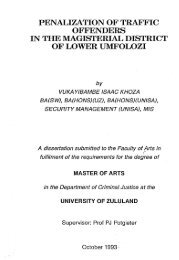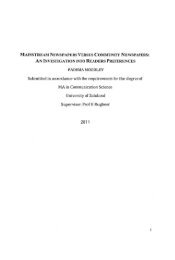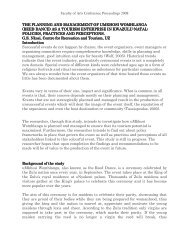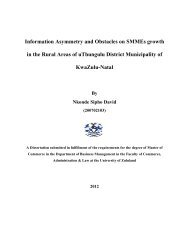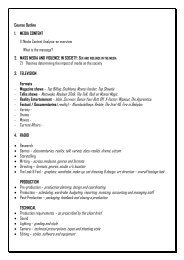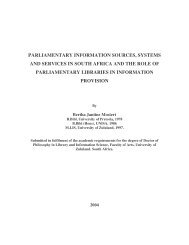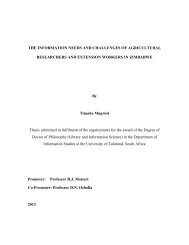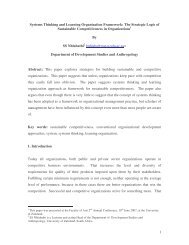- Page 2 and 3: .IIIU IA0603897A
- Page 4 and 5: ABSTRACfDECEPTIVE COMMUNICAnONWhen
- Page 6 and 7: ABSTRACTDECEPTIVE COMMCNIC\nONWhen
- Page 9 and 10: TABLE OF CONTENTSChapter 1 _ _ _ _
- Page 11 and 12: The use ofpower in the construction
- Page 13 and 14: Lies to protect the suffering .. 13
- Page 15 and 16: DISTANCE ..••....•....••.
- Page 17 and 18: WRITING CONVENTIONSI wish to draw t
- Page 19 and 20: ACKNOWLEDGMENTSI owe a debt ofgrati
- Page 21 and 22: Figure 45: "]am who others think]am
- Page 23 and 24: Question 3: What are young people's
- Page 25 and 26: danger when a life is threatened. B
- Page 27 and 28: Chapter 2KEy CO:-;CEPTSINTRODUCTION
- Page 29 and 30: DIVERSIONAccording to Caldwell (200
- Page 31 and 32: IMPOSTOREnema World English Diction
- Page 33 and 34: OMISSIONBIair et a1 (2001: 58) dese
- Page 35 and 36: context in which something is estab
- Page 37 and 38: Chapter 3THEORETIC~L GROC"iDI"iG FO
- Page 39 and 40: CONCEPTUAL BLENDINGFauconnier and T
- Page 41 and 42: I~I \ ,~YOLitcr Space I~i·····
- Page 43 and 44: persoruJ1, social, mental, emotiona
- Page 45: NATHAN'S PARABLE AS A TEST OF THE T
- Page 49 and 50: According to Gass and Seiter (2003:
- Page 51 and 52: attractiveness, or the sheer quanti
- Page 53 and 54: Gass and Seiter (2003: 37-40) add t
- Page 55 and 56: Bok (1978: 19) stresses that a soci
- Page 57 and 58: 6. Heuristic processing relies on m
- Page 59 and 60: Chapter 4C(J~I.\IUl'JIC\TIOl\INTROD
- Page 61 and 62: problem was not likely ever to be s
- Page 63 and 64: Encyclopaedia Brirnnmc" (2004) expl
- Page 65 and 66: Conununication is a two-way process
- Page 67 and 68: According to Miller and Stiff (1983
- Page 69 and 70: SYMBOLS AND MEANINGAccording to Gas
- Page 71 and 72: ooGod TmJlS, carry the greatest ble
- Page 73 and 74: ofimnation ProcessingTheoryG.iss an
- Page 75 and 76: Eco (1978: 3--8) adds that when the
- Page 77 and 78: which the one in the dominant posit
- Page 79 and 80: In doing this, states Sanes, they r
- Page 81 and 82: promise something to someone, and w
- Page 83 and 84: ooRequests: "It would be nice ifyou
- Page 85 and 86: Chapter 5DECEPTI01' IK A~I~L\LSINTR
- Page 87 and 88: Krebs maintains that in say 10 000
- Page 89 and 90: loodstream in times of stress. The
- Page 91 and 92: Bailey (1994: 130) adds that senses
- Page 93 and 94: INFLUENCE STRATEGIES AND COURTSHIP
- Page 95 and 96: that might be cast by the spider's
- Page 97 and 98:
kind of fork at the end of their ta
- Page 99 and 100:
Communication evolves because it en
- Page 101 and 102:
oThe mental operation that detennin
- Page 103 and 104:
THE PROBLEMATICS OF psycmc DEFENCEG
- Page 105 and 106:
Goleman adds that a telling sign of
- Page 107 and 108:
powerful that they disrupt the abil
- Page 109 and 110:
activity of the brain is so "nerget
- Page 111 and 112:
are comformble enough to allow peop
- Page 113 and 114:
COGNITIVE DISSONANCESternberg (1998
- Page 115 and 116:
involves a breakdown in self-enhanc
- Page 117 and 118:
I will discuss the Enigma machine,
- Page 119 and 120:
Bok (1978: 39) explains that there
- Page 121 and 122:
ooDefence: unwillingness to admit t
- Page 123 and 124:
The following table gives the meani
- Page 125 and 126:
Which technique a liar chooses, dep
- Page 127 and 128:
In stage 2, children no longer thin
- Page 129 and 130:
less consideration is given to mora
- Page 131 and 132:
Ekman (1989) maintains that the sec
- Page 133 and 134:
Coetzee and Russel (2000: 16-17) go
- Page 135 and 136:
Karen acts out a weak sort of lie;
- Page 137 and 138:
According to Ekman (1989: 29-30) bo
- Page 139 and 140:
who "knew" rlmt his own election wa
- Page 141 and 142:
fact that they are so common provid
- Page 143 and 144:
from a Iatge number of marginally h
- Page 145 and 146:
Bok (1978: 67) cites the example of
- Page 147 and 148:
THE DAMAGE DONE BYBENEVOLENT LIESSm
- Page 149 and 150:
You do not even have favourable odd
- Page 151 and 152:
type of relationship (marriage, eng
- Page 153 and 154:
others go a step further by imperso
- Page 155 and 156:
DECEPTION IN RESEARCHStemhetg (1998
- Page 157 and 158:
Berger and Burgoon (1995: 74-75) ad
- Page 159 and 160:
understand them (sometimes requirin
- Page 161 and 162:
Word M .Babalaasbek A drunkard, one
- Page 163 and 164:
a• __......!..~.~.- -c·-•.._-_
- Page 165 and 166:
SPIESAT COURTMelton (1996: 18-19) s
- Page 167 and 168:
Melton (1996: 36) states that spies
- Page 169 and 170:
developed a dictionary and numerous
- Page 171 and 172:
ENIGMAMACHINEAccording to Melton (1
- Page 173 and 174:
PmSHINGAccording to Wikipedia (2004
- Page 175 and 176:
ordinary risks ofhann incurred by t
- Page 177 and 178:
Emon's deceptive financial reportin
- Page 179 and 180:
CONCLUSIONlIDs chapter consisted of
- Page 181 and 182:
Chapter 8PERSUASION AND PROPAGANDAI
- Page 183 and 184:
difference between situations in wh
- Page 185 and 186:
PROPAGANDA AND EMOTIONSJackall (199
- Page 187 and 188:
no longer periphetal but quite cent
- Page 189 and 190:
DoUBLESPEAKGass and Seiter (2003: 1
- Page 191 and 192:
Language use in advertisingSymbols
- Page 193 and 194:
matter fo.rgotten. He draws a red h
- Page 195 and 196:
This poster is a metaphor, which re
- Page 197 and 198:
THE PERSUASIVE POWER OF CHARISMAAcc
- Page 199 and 200:
Chapter 91HE REL\TIONSHIP BE1WEEN N
- Page 201 and 202:
The good observer watches those par
- Page 203 and 204:
Figure 16: NOTlVerbal communication
- Page 205 and 206:
goals but also their ability to pro
- Page 207 and 208:
politicians, lawyers, actors and te
- Page 209 and 210:
said Several studies indicate that
- Page 211 and 212:
often have incorrect beliefs about
- Page 213 and 214:
Hands-otJapptUachBriggs (2000: http
- Page 215 and 216:
polygraph and voice stress amlysis
- Page 217 and 218:
how confident witnesses are, sugges
- Page 219 and 220:
Chapter 10EnUCAL PERSPECTIVES ON DE
- Page 221 and 222:
good or bad depends on the situatio
- Page 223 and 224:
intent, sincerity, encouragement of
- Page 225 and 226:
In the table below, Gass and Setter
- Page 227 and 228:
To understand the nature of persuas
- Page 229 and 230:
with an attempt of her/his own. All
- Page 231 and 232:
ETIlICSAND DECEPTIONGass and Seiter
- Page 233 and 234:
Bible warns against the use of lies
- Page 235 and 236:
CONCLUSIONIn this chapter I defined
- Page 237 and 238:
to my sutVey being conducted with t
- Page 239 and 240:
Questions 31 to 36 ask how wrong it
- Page 241 and 242:
NameV...lue I dbelsTypeDecimalsLabe
- Page 243 and 244:
question. As can be seen from the s
- Page 245 and 246:
15% felt it was quite wrong, while
- Page 247 and 248:
Chapter 12RESULTSINTRODUCTIONIn thi
- Page 249 and 250:
on sensitive issues relating to dec
- Page 251 and 252:
(1) of"No response". Compared to th
- Page 253 and 254:
Self-image by ethnic groupLegendI.'
- Page 255 and 256:
covers up infonnation falsdy presen
- Page 257 and 258:
The use oftactAccording to GoletruU
- Page 259 and 260:
Almost 19% (17) of the male respond
- Page 261 and 262:
the question. Spoilt responses were
- Page 263 and 264:
proposed that the terms covert and
- Page 265 and 266:
Chapter 13INTRODUCTIONIn this, the
- Page 267 and 268:
so that one lie after another rarel
- Page 269 and 270:
BibliographyAurHORED REFERENCESAdle
- Page 271 and 272:
Carberry, S. (1990). Plan rC(ogniti
- Page 273 and 274:
HeiJrnaDD, Mario, F. (Cndated). Soc
- Page 275 and 276:
Moore, M. S. (1995). The role of'ry
- Page 277 and 278:
Tinbergen, Niko. (1969). AnimalBeha
- Page 280 and 281:
ADDENDUM 1: QUESTIONNAIRET6
- Page 282 and 283:
lVB: Mark only one option per quest
- Page 284 and 285:
12. Cheating in a test is a form of
- Page 286 and 287:
24. Tact sometimes requires saying
- Page 288 and 289:
36. How wrong is it for parents to
- Page 290 and 291:
46. During the 1960 Vietnam War the
- Page 292 and 293:
ADDENDUM 2: TABLES
- Page 294 and 295:
Correlations!I am whoothersthink I
- Page 296 and 297:
INDEXAabsolute social hierarchy, 94
- Page 298 and 299:
234,236,238,239,240,241,242,256,296
- Page 300 and 301:
123, 126, 128, 129, 130, 132, 137,
- Page 302 and 303:
fear, 50, 86, 116, 117,121,130,140,



